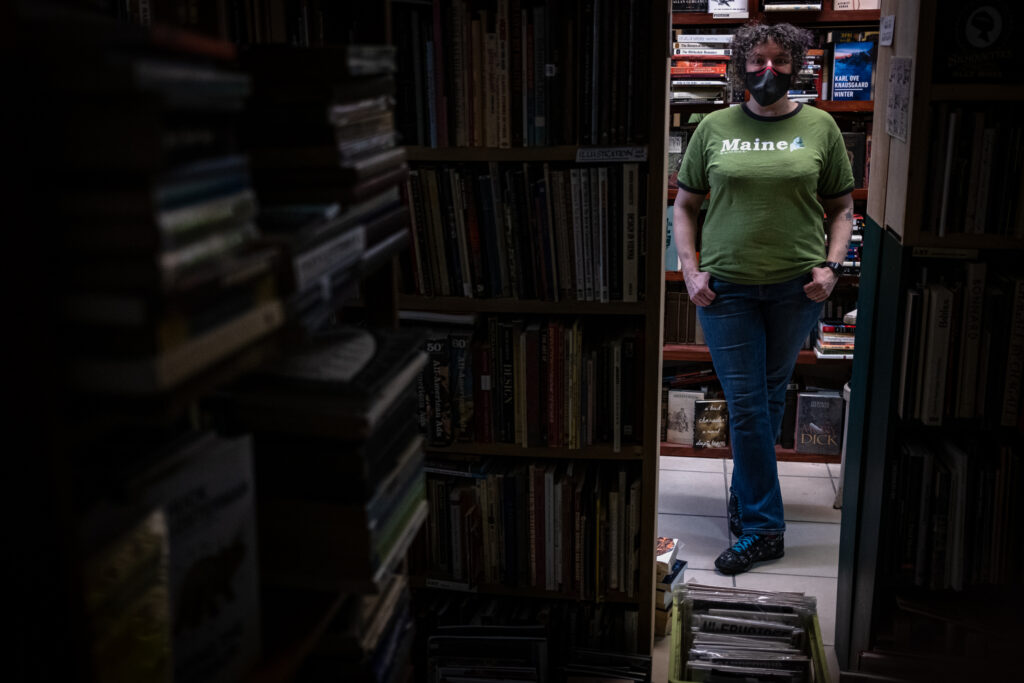
Mainers’ near run-ins with Bigfoot showcased in new book and film
By Troy R. Bennett, Bangor Daily News Staff
It was a perfect day for fishing. Rising trout dimpled the smooth, dark waters of Green Pond in Moro Plantation. Jeff Kaine savored the day, floating and casting until nearly dark. It was one of his favorite spots in all Aroostook County and Kaine had angled trout there at least a dozen times before.
Around 7 p.m. a deep, angry, resonant roar exploded across the water. The sudden blast left Kaine frozen in fear. Every hair on his body was standing straight up when the howl finally ended, a full five seconds later.
Kaine then paddled for shore as fast as he could, ran up a hill to his truck and tore off down the dirt access road, still wearing his waders.
“I was freaked the hell out,” Kaine said. “I’ve never heard any animal sound like that before and no human could ever replicate what I heard that evening.”
That was May 2007. He hasn’t been back since.

BIGFOOT IN MAINE — Author and bookstore owner Michelle Souliere stands in her shop, The Green Hand, on Congress Street in Portland. Souliere’s new book “Bigfoot in Maine” will be published on May 24.
The frightening encounter is one of many chronicled in two new projects exploring the enduring legend of Bigfoot in the Pine Tree State. Author Michelle Souliere’s book “Bigfoot in Maine,” is due out in May, published by The History Press. Filmmaker Nathaniel Brislin’s independent documentary “Eyes From the Pines: The Pine Ape Project” is slated for release this summer.
Both book and film trace the lengthy history of local Bigfoot tales, from traditional Native American stories, to contemporary run-ins like Kaine’s. They also examine likely explanations and why such tales abide, despite a complete lack of photographic evidence.
Souliere’s forthcoming book is not her first dive into extraordinary Maine stories. She previously published the “Strange Maine Gazette” newsletter. The one-page broadsheet was dedicated to odd, antique, local tales. Souliere, who owns The Green Hand bookstore in Portland, also wrote a book of short history pieces called “Strange Maine,” published by The History Press in 2010.
“My specialty is anomalous Maine history, the stuff that slips between the cracks, the stuff that isn’t in the history books,” Souliere said.
Bigfoot’s story in Maine begins with ancient Wabanaki traditional stories about a giant, manlike creature, known as the Wendigo, who frequents the Maine woods. The beast is said to possess the bodies of humans, turning them into cannibals. Later, 18th century white settlers told of a forest “wild man” who killed and dismembered trappers and hunters.
The first accounts of what we might think of as classic Bigfoot began in the late 1800s. The now defunct weekly paper, the Waterville Sentinel, published a story in 1886 about a 10-foot-tall, hairy, muscled creature who killed a man camping 100 miles north of Moosehead Lake.
Not all of Maine’s Bigfoot tales are archaic. In the 10 years it took to write “Bigfoot in Maine,” Souliere found 20 living eye (and ear) witnesses. The oldest goes back to the 1960s.
“The majority were people who simply encountered something they couldn’t explain,” she said. “They know they saw something. It wasn’t misidentified, it wasn’t somebody dressed in a suit. It was something else, something inexplicable.”
Most of the witnesses Souliere tracked down, like Kaine, were frightened by their experience. Many, fearing ridicule, never told anyone about what they saw before talking to Souliere.
Taking a scientific turn in one section of the book, Souliere points out how Maine’s woods are perfectly suited for a large number of mammals like coyotes, foxes, lynx and bear.
“We can also hypothesize that the [Bigfoot] creature would be an opportunistic eater, or omnivore, much like the black bear,” she said. “That means it would make use of available plant growth harvests, as well as meat from local wildlife.”
Brislin’s documentary takes a similar approach as Souliere’s book. He interviews eyewitnesses, both anonymous and named, along with subject matter experts. Bigfoot’s deep Maine roots are also laid out.
“It’s very Maine-centric,” said Brislin, who grew up in Buxton but now calls Biddeford home.
For added entertainment value, he also included a few dramatic recreations. Despite numerous eyewitness accounts, no known photographic evidence from Maine is known to exist.
“We actually bought two gorilla suits,” Brislin said, “and did some b-roll shooting.”
Though the film is mostly devoted to other people’s stories, Brislin has had his own unexplained experiences in the woods. One night, he and his family were sitting around a fire, just outside their camp in Piscataquis County.
“Out of nowhere, we hear wood hitting wood — like a hammer — way out in the woods,” Brislin said, “and there’s no houses around.”
Wood-banging tales are fairly common in Bigfoot lore.
On another occasion, near the end of the day, Brislin and his father sat on a cabin porch, listening to a large animal make its way through the trees, not far off. When it got to a nearby creek, they realized it was no animal they’d ever heard before. Its wet footfalls were distinctly two-legged.
“Like a person stepping through shallow water at the beach,” Brislin said.
Both the book and film feature the founder of Portland’s International Cryptozoology Museum, Loren Coleman. Cryptozoology is the study of creatures that may, or may not, exist.
Coleman’s museum used to occupy the back half of Souliere’s store and he wrote the foreward to her book. Brislin currently works for Coleman’s museum and he appears in the film, though it is an independent project not associated with his museum.
Neither Brislin nor Souliere claim to know the absolute truth about Bigfoot in Maine but both understand the enduring allure: It’s fun, fascinating and a little scary.
“The more we talk about it, the more we’ll understand,” Souliere said. “I’m intrigued.”
Brislin describes his own position carefully.
“I won’t say that I believe in Bigfoot because belief is blindly putting faith in something,” he said. “I’m trying to look for the evidence to convince myself first, and then maybe other people, too.”
Souliere believes her subjects, even if she’s not quite sure about Bigfoot.
“The people I talked to have seen something that doesn’t match any of the other large mammals in the state,” she said. “They’re not lying to me, and there’s no reason another large mammal can’t exist here, based on the natural resources we have in Maine.”